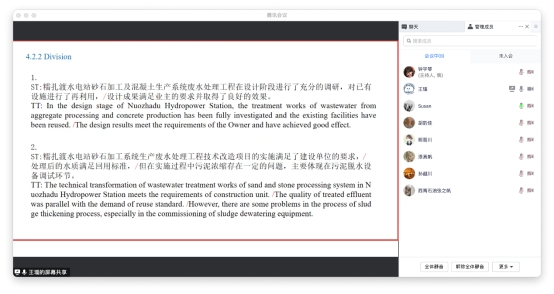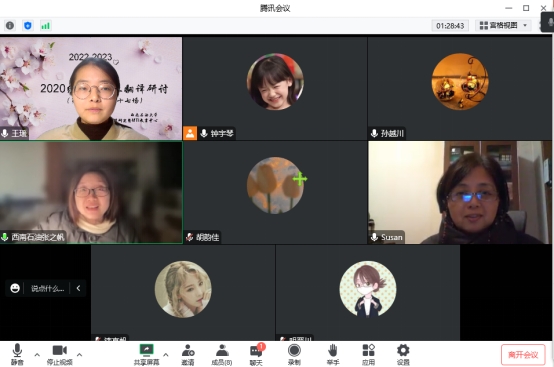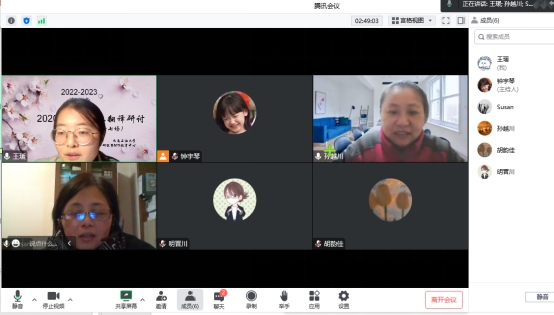汇报时间:2022年12月22日20:00-21:30
汇报地点:腾讯会议911-260-505
汇报学生:王瑗
指导教师:孙越川
汇报题目:《中国超级水电工程生态环境工程创新技术》(第九章至第十章)汉英翻译实践报告
参与导师:孙越川、张之帆、何姗
内容简介:
《中国超级水电工程生态环境工程创新技术》是一本水电工程类专著。该专著属于国家出版基金——《大国重器 中国超级水电工程·糯扎渡卷》之《中国超级水电工程生态环境工程创新技术》分册。原文由中国电建集团昆明勘测设计研究院与成都勘测设计研究院共同完成,主要总结了糯扎渡水电站中采用的工程创新技术。
译者的文本内容为该专著的第九章生活垃圾处理工程、第十章结语与展望。第九章生活垃圾处理工程主要介绍了糯扎渡水电站在生活垃圾处理上所使用的创新技术。以生活垃圾排放特征、国家相关政策要求、水电工程生活垃圾主要处理模式及应用情况、生活垃圾处理工程设计、实施情况和效果分析、工程设计创新点及亮点、存在问题及建议分别进行阐述。第十章则是对全书进行了概括总结。分别对叠梁门分层取水工程、鱼类增殖站工程、珍稀植物园工程、动物救护站工程、水土保持工程、移民安置环境保护工程、高浓度砂石废水处理工程、生活垃圾处理工程创新技术进行了高度的概括总结。
在翻译该文本的过程中对难点进行了提炼,具体如下:
1、专业背景知识:水电工程类专业背景知识欠缺,涉及到的专业工艺流程较多,理解上有一定困难。
2、 术语确定:文本中存在大量专业术语,查找仅能确定一部分,还需多途径多方求证。
3、在三个层面进行分析:
(1)在词汇层面,主要探讨增减译、词性转换;
(2)在句法层面,主要着眼于句序调整、长句拆分;
(3)在篇章层面,主要分析上下文形式一致。
译文修改:
例1:
ST: 昆明院作为电站设计单位也不例外,对环境保护水土保持的总体设计或专项设计都本着高标准、严要求的原则,在四新技术的应用方面不遗余力,在基础研究匮乏,并缺乏可资借鉴的成熟经验和技术的情况下,大胆探索,勇于创新。
TT1: Kunming Institute, the Designer of the power station, is no exception to the principle of high quality and strict requirements for the overall design or special design of environmental protection and soil conservation. It spares no effort in the application of “four new technologies” (new technique, process, materials and equipment), boldly exploring and innovating in the absence of basic research, mature experience and technology.
TT2: Kunming Institute, the Designer of the power station, is no exception to the principle of high quality and strict requirements for the overall design or special design of environmental protection and soil conservation. It spares no effort in the application of new technique, new process, new materials and new equipment, boldly exploring and innovating in the absence of basic research, mature experience and technology.
例2:
ST: 目前国内外对生活垃圾的处理方式主要有四种:卫生填埋、焚烧、堆肥和综合处理,其中综合处理是指以分类回收为前提所开展的无害化、资源化和减量化为目标,集堆肥、焚烧和填埋为一体的综合处理方式,其特点是可使垃圾得到合理处理和利用,克服了单一填埋、焚烧和堆肥的缺点,但投资较大,操作工序复杂,管理水平要求高,运行成本也较大,较适合大中型城镇的生活垃圾处理。
TT1: At present, there are mainly four methods to dispose domestic refuse at home and abroad: sanitary landfill, incineration, composting and comprehensive treatment. Among them, the comprehensive treatment method is a comprehensive treatment method integrated with composting, incineration and landfilling, with the goal of harmless, recycling and reducing treatment based on the premise of classification and recycling. Its characteristics are that garbage can be reasonably treated and utilized without the shortcomings of single landfill, incineration and composting. Nevertheless, it has some defects such as strong investment, complicated operation process, high management requirements and high operating costs. Thus, this model is more suitable for domestic waste treatment in large and medium-sized cities and towns.
TT2: At present, domestic refuse at home and abroad are usually disposed by means of sanitary landfill, incineration, composting and comprehensive treatment. Among them, the comprehensive treatment method is a comprehensive treatment method integrated with composting, incineration and landfilling, with the goal of harmless, recycling and reducing treatment based on the premise of classification and recycling. Its characteristics are that garbage can be reasonably treated and utilized without the shortcomings of single landfill, incineration and composting. Nevertheless, it has some defects such as strong investment, complicated operation process, high management requirements and high operating costs. Thus, this model is more suitable for domestic waste treatment in large and medium-sized cities and towns.
例3:
ST: 在糯扎渡水电站集中移民安置点生活污水处理工程设计中,昆明院根据《农村生活污染防治技术政策》,考虑了大中型水电工程地处山区,移民安置点之间距离较远,居民生活污水难以统一收集后再集中处理的特点,参照国内农村分散污水处理的先进经验,制定了一套以集中安置点为单元,以分流制污水管网收集住户、公厕等生活污水,然后再统一由污水处理站(以湿地为主的小型化污水处理设施)集中处理的污水处理技术路线。
TT1: In the design of the domestic sewage treatment works for the centralized resettlement sites of Nuozhadu Hydropower Station, according to the Rural Domestic Pollution Prevention and Control Technology Policy, Kunming Institute prepares a technical roadmap for sewage treatment by taking the centralized resettlement site as unit, collecting domestic sewage of households and public toilets by separate sewage networks, and centralized treatment of the sewage treatment station (small sewage treatment facilities of wetlands), in consideration of the features that large and medium-sized hydropower projects are located in mountainous, and the distance between one resettlement and the other resettlement is relatively far, and that it is difficult to collect and treat domestic sewage from residents in a centralized manner, and referring to the advanced experience of decentralized sewage treatment in rural areas in China.
TT2: In the design of the domestic sewage treatment works for the centralized resettlement sites of Nuozhadu Hydropower Station, Kunming Institute prepares a technical roadmap for sewage treatment according to the Rural Domestic Pollution Prevention and Control Technology Policy, by taking the centralized resettlement site as unit, collecting domestic sewage of households and public toilets by separate sewage networks, and centralized treatment of the sewage treatment station (small sewage treatment facilities of wetlands), in consideration of the features that large and medium-sized hydropower projects are located in mountainous, and the distance between one resettlement and the other resettlement is relatively far, and that it is difficult to collect and treat domestic sewage from residents in a centralized manner, and referring to the advanced experience of decentralized sewage treatment in rural areas in China.
研讨反思:
通过此次研讨,增加了我对翻译的认识,主要的收获有以下三点:
第一、术语统一的重要性。专著具有篇幅较长、字数较多的特点,常以合译形式出现。所以应与合译的译者一同保持术语的统一性、规范性;
第二、确认源语中是否存在缺少标点符号。源语中有多处读不通、明显缺少标点的情况,这会极大地影响译者的理解和翻译。所以应先仔细校对原文,进行求证、标注后再进行恰当的翻译;
第三、注重用词的准确性。在翻译研讨过程中,需斟酌考究备选词。比如:“土著鱼类”,选用native fishes, indigenous fishes, local fishes哪一个是最合适的。所以在翻译选词时,我们应该多查阅相关资料,选取最适合的译词。
照片:


